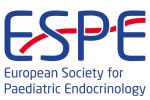ESPE2019 Poster Category 1 GH and IGFs (12 abstracts)
Impact of -202 IGFBP-3 Promoter Polymorphism on Growth Responses in Korean Children with Idiopathic Short Stature
II Tae Hwang 1 , Kyung Hee Yi 2 , Eun Young Kim 3 & Seung Yang 1
1Hallym University College of Medicine, Seoul, Korea, Republic of. 2Wonkwang University Sanbon Medical Center, Gunpo, Korea, Republic of. 3Chosun University School of Medicine, Gwangju, Korea, Republic of
Purpose: Our previous study showed no correlation between -202 A/C IGFBP-3 promoter polymorphism and Δheight SDS in children with growth hormone deficiency. We investigated the influences of the -202 IGFBP-3 polymorphism on 1-year follow-up outcomes of GH treatment in Korean children with ISS.
Methods: Data was obtained from 81 children with idiopathic short stature (peak serum growth hormone (GH) ≥ 7.0 ng/mL by GH stimulation test with 2 different stimulants). They were treated with GH for at least 1 year between 2014 and 2016. 69 of them were analyzed polymorphism of -202 IGFBP-3 promoter region (A or C). Their height velocity during GH treatment, serum insulin-like growth factor-1 (IGF-1) and insulin-like growth factor binding protein-3 (IGFBP-3) concentrations before and after GH treatment, respectively. Children with chronic disease, known syndromic disease and small for gestational age (SGA).
Results: Distribution of the -202 IGFBP-3 genotypes was as follows: AA genotype 69.6%; AC genotype 24.6%; and CC genotype 5.8%. Comparing the AA group with the AC and CC group, significant difference was observed in serum IGFBP-3 concentration at diagnosis (P=0.032) but no significant difference after the treatment (P=0.499). There were no statistically significant differences in ΔHeight, Δ IGF-1 level, and Δ IGFBP-3 level before and after GH treatment between two allele groups. No significant difference between C allele frequency and ΔHeight SDS was seen (P=0.935).
Conclusion: The results suggest that -202 IGFBP-3 promoter polymorphism may not be a major factor in GH treatment in Korean children with ISS.



